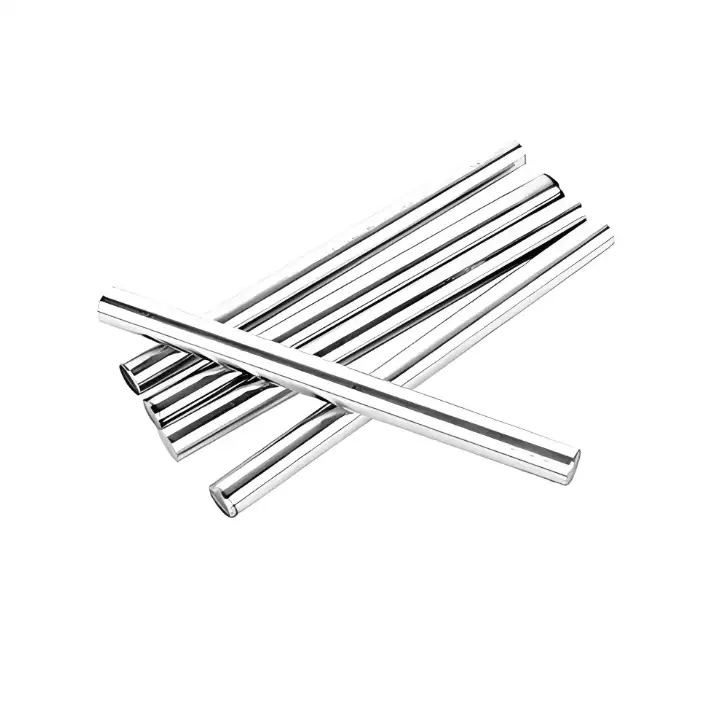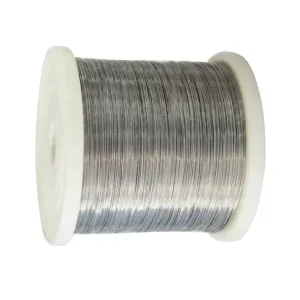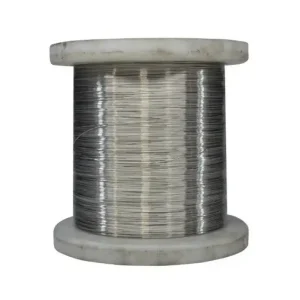Hastelloy G‑30 is a nickel‑chromium‑iron superalloy engineered for outstanding resistance to “wet process” phosphoric acid (P₂O₅) and other oxidizing acids, while maintaining strength and durability in demanding chemical environments. At MWalloys, we supply custom G‑30 in plates, bars, rods, coils, wire, pipes, and covered electrodes—tailored to your process requirements.
What Is Hastelloy G‑30?
Hastelloy G‑30 (UNS N06030) is an evolution of Alloy G‑3, featuring higher chromium and additions of cobalt and tungsten for enhanced corrosion resistance in phosphoric, nitric, and other oxidizing acids.
Specifications & Parameters
| Category | Property | Value / Specification | Notes / Conditions |
|---|---|---|---|
| Chemical Composition | Nickel (Ni) | Balance (≥42%) | Primary constituent |
| Chromium (Cr) | 28.0–31.5% | Key for oxidation resistance | |
| Iron (Fe) | 13.0–17.0% | ||
| Molybdenum (Mo) | 4.0–6.0% | Enhances corrosion resistance | |
| Copper (Cu) | 1.0–2.4% | Critical for sulfuric/phosphoric acid resistance | |
| Tungsten (W) | 1.5–4.0% | ||
| Cobalt (Co) | ≤5.0% | ||
| Manganese (Mn) | ≤1.5% | ||
| Silicon (Si) | ≤0.50% | ||
| Carbon (C) | ≤0.03% | ||
| Physical Properties | Density | 8.9 g/cm³ | |
| Melting Range | ~1350°C (2460°F) | Estimated | |
| Thermal Conductivity (100°C) | 9.1–14.0 W/m·K | ||
| Electrical Resistivity | 1.2 × 10⁻⁶ Ω·m | ||
| Coefficient of Thermal Expansion (20–100°C) | 13.4–13.9 × 10⁻⁶/°C | ||
| Mechanical Properties | Tensile Strength (RT, Annealed) | 760–880 MPa (min: 524 MPa per ASTM) | Higher range from industrial tests; ASTM min for annealed state |
| Yield Strength (0.2% Offset, RT) | 350–450 MPa (min: 200 MPa per ASTM) | ||
| Elongation (RT) | 35–45% (min: 62% per ASTM) | ASTM min value is exceptional | |
| Hardness (Annealed) | 210–250 HB | ||
| Elevated-Temp Properties | Tensile Strength (800°C) | ~600 MPa | |
| Yield Strength (800°C) | ~280 MPa | ||
| Elongation (800°C) | ~30% | ||
| Fatigue Life (300 MPa Stress) | >10⁷ cycles | ||
| Heat Treatment | Solution Annealing | 1177°C (2150°F), rapid air/water cool | Mandatory for all forged products |
| Corrosion Resistance | Phosphoric/Sulfuric/Nitric Acids | Excellent (superior to most Ni/Fe alloys) | |
| Mixed Acids (e.g., HNO₃/HF, HNO₃/HCl) | Exceptional resistance | ||
| Welded Joint Performance | Resists grain-boundary precipitation | ||
| Fabrication | Welding Methods | GTAW, GMAW, SMAW (filler: ERNiCrMo-11/ENiCrMo-11) | Avoid submerged arc welding |
| Cold Working | Recommended (higher energy required vs. stainless steel) | ||
| International Standards | Bar/Rod | ASTM B581 | |
| Plate/Sheet | ASTM B582 | ||
| Seamless Tube | ASTM B622 | ||
| Welded Tube | ASTM B619, B626 | ||
| Forgings/Fittings | ASTM B462, B366 | ||
| Key Applications | Chemical Processing | Phosphoric/sulfuric/nitric acid reactors, pickling equipment | |
| Nuclear Industry | Fuel reprocessing, nuclear waste handling | ||
| Petrochemicals | Fertilizer/pesticide production, gold ore extraction |
🔑 Critical Notes & Variability Factors
-
Mechanical Property Discrepancies:
-
Strength/Elongation: Industrial data (e.g., UTS 760–880 MPa) often exceeds ASTM minima (UTS ≥524 MPa). Higher values reflect optimized processing; ASTM values are conservative guarantees.
-
High-Temp Performance: Strength declines linearly with temperature (e.g., UTS drops 21% at 800°C vs. RT) but remains superior to standard stainless steels.
-
-
Corrosion Performance Highlights:
-
Acid Blends: Uniquely resistant to aggressive mixtures (e.g., HNO₃/HF), making it ideal for acid cleaning and metal refining.
-
Welding Integrity: Low carbon/niobium content prevents sensitization in weld zones—critical for nuclear/pressure applications.
-
-
Fabrication Constraints:
-
Cold Working: Requires 20–30% more power than 304 stainless due to higher work-hardening rate.
-
Thermal Stability: Prolonged exposure above 650°C may cause embrittlement; limit to 600°C for critical service.
-
-
Standards Compliance:
-
Nuclear/chemical grades enforce strict Co/W/Cu ratios to avoid corrosion hotspots.
-
💎 Summary: Hastelloy® G-30 combines extreme acid resistance with robust high-temp strength, outperforming most alloys in oxidizing/acidic environments. Its weldability and ASTM-standardized reliability make it indispensable for nuclear, chemical, and mineral processing. For project-specific validation, consult ASTM B581/B582 directly.
global price comparison
| Form | China (USD/kg) | Europe (USD/kg) | USA (USD/kg) | India (USD/kg) |
|---|---|---|---|---|
| Plate/Sheet | 20 – 21 /kg — Alibaba (min. 1 kg) |
27 – 33 /kg | 45 – 55 /kg (distributor quotes) | 27 – 30 /kg |
| Bar / Rod | 28 – 35 /kg — Alibaba round bar listings |
33 – 38 /kg | 40 – 50 /kg (ASTM B581 stockists) | 35 – 40 /kg — Robust Special Metals |
| Coil / Strip | 20 – 30 /kg (Alibaba coil listings) | 30 – 35 /kg | 45 – 55 /kg (heat‑exchanger coil suppliers) | 40 – 45 /kg |
| Wire | 20 – 25 /kg (spring & strip wire) | 37 – 48 /kg | 60 – 80 /kg (welding/design wire) | 50 – 53 /kg |
Key Sources & Notes:
-
China: Plate/sheet at US$20–21 /kg (min. 1 kg); bar/rod at US$28–35 /kg under ASTM B581.
-
India: Rod prices range $35–40 /kg (₹1,890–3,000/kg) for ASTM B581 round bars.
-
Europe & USA: Estimated distributor and mill‑stockist ranges, reflecting typical premiums for certified, low‑volume orders.
❓ Tip: For precise factory‑direct quotes (including certifications like ASTM B575/B581, material test certificates, and surface finish), contact MWalloys for a 24‑hour turnaround.
Why Choose G‑30?
-
Exceptional Acid Resistance: Outperforms most nickel‑ and iron‑base alloys in phosphoric, nitric, and mixed acids.
-
Stress‑Corrosion Cracking Resistance: Less susceptible than stainless steels under chloride deposits.
-
Balanced Mechanical Strength: High tensile and yield strength combined with modest ductility.
-
Versatile Forms: Available as plate, bar, rod, coil, wire, tube, and electrode.
Manufacturing & Forming Alloy G‑30
We offer G‑30 in hot‑rolled, cold‑rolled, and solution‐annealed conditions. Typical fabrication guidelines:
-
Hot Working: 1,050–1,200 °C.
-
Cold Working: Increases strength; follow with solution anneal (1,200–1,250 °C).
-
Machining: Use rigid tooling and moderate feeds to manage work‑hardening.
Comparison with Similar Alloys
| Property | G‑30 | Inconel 625 | Alloy G‑3 |
|---|---|---|---|
| Cr Content | 30 % | 20–23 % | 22–24 % |
| Acid Resistance | Superior (P₂O₅) | Excellent | Very good |
| Tensile Strength | 1,096 MPa | 1,030 MPa | ~950 MPa |
| Chloride SCC | Moderate | Excellent | Moderate |
| Primary Uses | Phosphoric acid | Marine, chemical | Chemical, heat |
Welding Practices
G‑30 welds via GTAW or GMAW using matching electrodes. Recommendations:
-
Preheat: Not required.
-
Interpass: < 150 °C.
-
Post‑weld: Solution anneal at 1,200 °C if service in severe acid environments.
FAQs
What makes Hastelloy® G‑30 especially resistant to “wet process” phosphoric acid?
G‑30’s high chromium content (30 wt %) forms a stable passive film that limits attack in 30–54 % P₂O₅ at 121 °C. It outperforms G‑3 and even Alloy 625 in these conditions, showing corrosion rates 2–10× lower than comparative alloys.
How does G‑30 perform in other oxidizing acids (e.g., nitric, sulfuric)?
Beyond phosphoric acid, G‑30 resists nitric and sulfuric acid mixtures thanks to added cobalt and tungsten—which enhance passivation—and molybdenum plus copper for localized attack resistance.
Is Hastelloy G‑30 susceptible to chloride-induced stress‑corrosion cracking?
No. G‑30 shows substantially lower cracking than austenitic stainless steels under ASTM G36 boiling magnesium‑chloride tests. Its nickel‑chromium matrix and lack of detrimental grain‑boundary precipitates in the as‑welded condition minimize SCC risk.
Can G‑30 be welded without losing corrosion resistance?
Yes. G‑30 welds via GTAW/GMAW with matching covered electrodes or wire. Its resistance to grain‑boundary precipitates in the weld‑heat‑affected zone means post‑weld annealing is typically unnecessary, even for critical acid services.
What industrial applications benefit most from Hastelloy G‑30?
Phosphoric acid evaporator tubes in fertilizer plants.
Nitric/hydrofluoric pickling hardware for stainless steel.
Heat‑exchanger tubing in mixed‑acid environments.
Furnace baskets and trays for oxidizing acids.
These uses leverage G‑30’s unique blend of strength, weldability, and superior resistance to highly oxidizing media.





